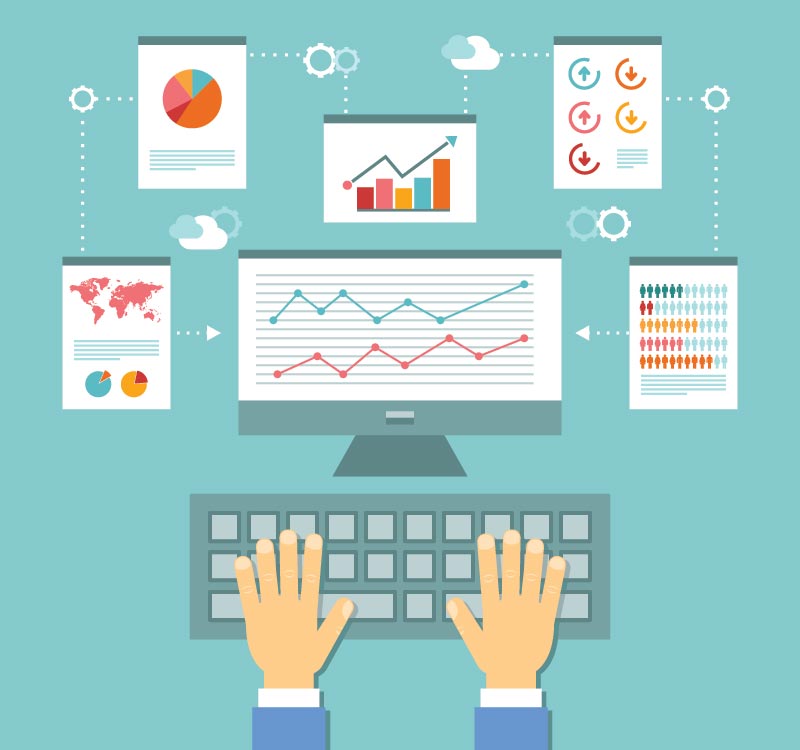In the realm of B2B marketing, data analytics has become an indispensable tool for driving smarter and more efficient lead generation. As we progress into 2024, the use of data analytics in B2B lead generation is not just a competitive advantage but a necessity. Businesses that harness the power of data analytics can gain deeper insights into their target audience, optimize their marketing strategies, and ultimately, generate higher-quality leads. This blog post explores how businesses can leverage data analytics to enhance their B2B lead generation efforts in 2024.
1. Understanding Your Target Audience
The foundation of any successful lead generation strategy is a deep understanding of your target audience. Data analytics enables businesses to gather and analyze vast amounts of data to create detailed customer profiles and buyer personas:
- Demographic Data: Analyze demographic information such as age, gender, location, and job title to identify who your ideal customers are.
- Behavioral Data: Track and analyze customer behavior, including website visits, content engagement, and purchasing history, to understand what drives their decisions.
- Psychographic Data: Collect data on customer interests, values, and lifestyle to tailor your messaging and offers to resonate with their needs and preferences.
By combining these data points, businesses can create comprehensive and accurate buyer personas, which serve as the basis for targeted marketing campaigns.
2. Optimizing Lead Scoring and Qualification
Lead scoring is a critical component of lead generation, helping businesses prioritize leads based on their likelihood to convert. Data analytics enhances lead scoring by providing a data-driven approach to evaluating leads:
- Predictive Analytics: Use predictive analytics to assess the probability of a lead converting based on historical data and behavioral patterns.
- Multi-Touch Attribution: Analyze the various touchpoints a lead interacts with throughout their buyer journey to determine their level of engagement and interest.
- Behavioral Triggers: Identify key actions or behaviors that indicate a lead’s readiness to move further down the sales funnel, such as downloading a whitepaper or attending a webinar.
With accurate lead scoring, businesses can focus their efforts on high-priority leads, improving conversion rates and sales efficiency.
3. Personalizing Marketing Campaigns
Personalization is a powerful strategy for enhancing lead generation, and data analytics makes it possible to deliver highly personalized marketing campaigns:
- Segmentation: Segment your audience based on various criteria such as industry, company size, and past interactions to deliver relevant content and offers.
- Dynamic Content: Use data to create dynamic content that changes based on the viewer’s characteristics or behavior. For example, personalized email content that addresses the recipient’s specific pain points.
- Real-Time Personalization: Implement real-time personalization techniques on your website, such as recommending products or content based on the visitor’s browsing history and preferences.
Personalized marketing campaigns resonate more with your audience, increasing engagement and the likelihood of conversion.
4. Enhancing Content Strategy
Content is a key driver of lead generation, and data analytics can significantly enhance your content strategy:
- Content Performance Analysis: Use analytics tools to measure the performance of your content, including metrics such as views, shares, and conversion rates. Identify which types of content resonate most with your audience.
- Content Gap Analysis: Identify gaps in your content by analyzing search data and customer feedback. Create content that addresses these gaps and meets the needs of your target audience.
- A/B Testing: Conduct A/B testing on different content formats, headlines, and CTAs to determine what works best. Use the results to optimize your content strategy continuously.
By leveraging data analytics, you can create a more effective content strategy that attracts and converts more leads.
5. Improving Lead Nurturing
Lead nurturing is essential for guiding prospects through the sales funnel and converting them into customers. Data analytics can help improve lead nurturing by providing insights into lead behavior and preferences:
- Automated Workflows: Set up automated email workflows that deliver relevant content and offers based on a lead’s actions and stage in the buyer journey.
- Lead Engagement Tracking: Track and analyze lead engagement with your emails, website, and other touchpoints to identify opportunities for personalized follow-ups.
- Behavioral Segmentation: Segment leads based on their behavior and engagement levels to tailor your nurturing efforts more effectively.
With data-driven lead nurturing, you can build stronger relationships with your prospects and move them closer to a purchase decision.

6. Measuring and Optimizing ROI
To ensure your lead generation efforts are effective, it’s crucial to measure and optimize your return on investment (ROI). Data analytics provides the tools to track and analyze the performance of your lead generation campaigns:
- Key Performance Indicators (KPIs): Define and track KPIs such as cost per lead, lead conversion rate, and customer acquisition cost to measure the success of your campaigns.
- Attribution Models: Use attribution models to understand the impact of different marketing channels and touchpoints on lead generation. This helps allocate resources more effectively.
- Campaign Analysis: Continuously analyze the performance of your campaigns to identify what’s working and what’s not. Use these insights to make data-driven adjustments and optimizations.
By regularly measuring and optimizing your lead generation efforts, you can ensure that you’re maximizing your marketing ROI.
7. Leveraging Advanced Technologies
In 2024, advanced technologies such as artificial intelligence (AI) and machine learning (ML) are playing a significant role in data analytics for lead generation:
- AI-Powered Insights: Use AI to uncover deeper insights from your data, such as identifying patterns and trends that might not be apparent through traditional analysis.
- Chatbots and Virtual Assistants: Implement AI-powered chatbots and virtual assistants to engage with leads in real-time, answer questions, and capture lead information.
- Predictive Lead Generation: Utilize ML algorithms to predict which prospects are most likely to become high-quality leads based on historical data and behavioral indicators.
These advanced technologies can enhance the accuracy and efficiency of your lead generation efforts, giving you a competitive edge.
Future Trends in Data-Driven B2B Lead Generation
As we look toward the future, several emerging trends are set to further revolutionize data-driven B2B lead generation. Staying abreast of these trends can help businesses maintain a competitive edge and continuously refine their lead generation strategies.
8. Integration of IoT Data
The Internet of Things (IoT) is generating vast amounts of data from connected devices. This data can provide valuable insights into customer behavior and preferences:
- Usage Data: Analyze how customers use your products to identify opportunities for upselling and cross-selling.
- Predictive Maintenance: Use IoT data to predict when a customer might need maintenance or support, offering timely solutions that enhance customer satisfaction and loyalty.
- Customer Experience: Leverage IoT data to understand and improve the overall customer experience by tailoring your offerings based on real-time usage patterns.
9. Voice Search and AI Assistants
The rise of voice search and AI assistants like Amazon’s Alexa, Google Assistant, and Apple’s Siri is changing how users find information and interact with technology:
- Voice SEO: Optimize your content for voice search by using natural language and answering common questions your target audience might ask.
- Conversational AI: Implement conversational AI technologies to engage with leads through voice interactions, providing personalized responses and gathering valuable data on customer needs.

10. Enhanced Privacy and Data Security
With increasing concerns about data privacy and security, businesses must prioritize ethical data practices and comply with regulations like GDPR and CCPA:
- Data Transparency: Be transparent about how you collect, use, and protect customer data. Clearly communicate your privacy policies and obtain explicit consent.
- Secure Data Handling: Implement robust data security measures to protect against breaches and ensure that customer data is handled securely.
- Ethical AI: Use ethical AI practices to ensure that your data-driven insights and decisions are fair, unbiased, and respect user privacy.
11. Blockchain for Data Integrity
Blockchain technology can enhance data integrity and trust in B2B lead generation:
- Data Verification: Use blockchain to verify the authenticity of lead data, ensuring that the information is accurate and tamper-proof.
- Secure Transactions: Implement blockchain for secure and transparent transactions, building trust with your leads and customers.
- Decentralized Data Management: Explore decentralized data management solutions to give users more control over their data and enhance privacy.
12. Social Listening and Sentiment Analysis
Social listening and sentiment analysis can provide real-time insights into how your brand is perceived and what your audience is discussing:
- Monitor Brand Mentions: Use social listening tools to monitor mentions of your brand, competitors, and industry trends across social media platforms.
- Sentiment Analysis: Analyze the sentiment of social media conversations to gauge public opinion and identify potential leads based on their expressed needs and interests.
- Engage Proactively: Engage with users who mention your brand or industry topics, addressing their concerns and positioning your business as a helpful resource.
Best Practices for Implementing Data Analytics in B2B Lead Generation
To effectively leverage data analytics for B2B lead generation, consider the following best practices:
1. Invest in the Right Tools and Technologies
Choose data analytics tools and platforms that align with your business goals and can integrate with your existing systems. Popular options include Google Analytics, HubSpot, Salesforce, and specialized AI-powered analytics tools.
2. Develop a Data-Driven Culture
Foster a data-driven culture within your organization by encouraging data literacy and training employees on the importance of data analytics. Ensure that decision-making processes are informed by data insights.
3. Prioritize Data Quality
Ensure the accuracy, completeness, and relevance of your data. Regularly clean and update your data to avoid inaccuracies that could lead to misguided decisions.
4. Collaborate Across Departments
Collaborate across marketing, sales, and customer service departments to share data insights and develop a unified lead generation strategy. Cross-functional collaboration can help align efforts and improve overall efficiency.
5. Continuously Monitor and Optimize
Regularly monitor your data analytics efforts and adjust your strategies based on insights. Use A/B testing, performance metrics, and feedback loops to continuously optimize your lead generation processes.
Conclusion
Leveraging data analytics for smarter B2B lead generation in 2024 is about more than just collecting data—it’s about transforming that data into actionable insights that drive business growth. By understanding your target audience, optimizing lead scoring, personalizing marketing campaigns, enhancing content strategies, improving lead nurturing, measuring ROI, and staying ahead of emerging trends, businesses can significantly enhance their lead generation efforts.
As technology continues to evolve, the integration of advanced tools like AI, IoT, and blockchain will further refine the landscape of B2B lead generation. Embracing these innovations and maintaining a data-driven approach will enable businesses to attract, engage, and convert high-quality leads more effectively, ensuring sustained success in an increasingly competitive market. By prioritizing data quality, fostering a data-driven culture, and continuously optimizing strategies, businesses can stay ahead of the curve and achieve their lead generation goals in 2024 and beyond.

